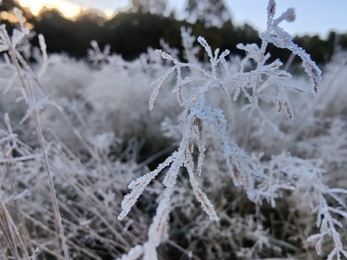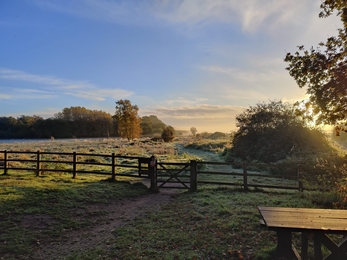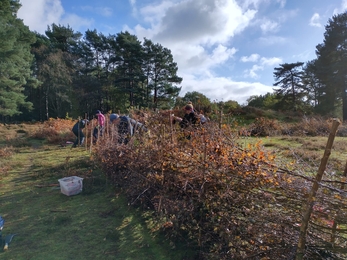Weekly wild news from our reserves – 12 November 2021
Frost at Redgrave & Lopham Fen – David Stansfeld
This ruby tiger moth caterpillar was spotted on the move at Hen Reedbeds this week. These caterpillars feed on various plants including ragwort, dandelion, dock, spindle and broom.
David’s frost
Depending on where you live in Suffolk will determine whether you have yet to experience conditions to warrant a morning frost yet. Certainly, inland at Redgrave & Lopham Fen we have seen one or two. Warden David captured these moments frozen in time whilst out and about with early morning tasks.
Great white egret
This film shows a great white egret feeding at Hen Reedbeds. Compared to the now familiar little egret, the great white egret is enormous, almost as large as a grey heron. A few decades ago, records of great white egret were less than annual, but many now winter in the UK and a few pairs even nest here. Visiting birds can be found in all kinds of wetland habitats, even farmland ditches! They stand in shallow water, waiting for fish, insects and amphibians to approach, then spear them with their dagger-like bill.
Compared to a grey heron, a great white egret has longer legs and a longer neck and only slightly smaller. It has a large, dagger-like bill that is yellow for most of the year but becomes mostly black in breeding birds. The upper legs are yellowish, sometimes turning reddish in breeding birds, and the lower legs and feet are black - unlike the yellow feet of the little egret.
Willow management
Our North East Team were busy managing willow scrub at Oulton Marshes this week. Willow management is necessary to maintain a varied age structure of scrub in the fen to ensure maximum edge habitat and abundance of insects that decline when scrub becomes too mature.
Crafty K-nettishall
Our volunteer team in the north-west of the county have been knitting and weaving as part of their conservation work this week. A dead hedge was constructed using cleared scrub from the heath to make stakes, which were then pointed and driven into the ground acting like intermediate fence posts. The felled brash and tops of small trees were then carefully woven between the structure to help create a natural barrier to direct footfall around the round barrow burial mound. On these cold mornings the extremities need time to warm up. What better way to help stay toasty than with hand-knitted ear defender covers as sported by one of the team here.
Lapwing abound
Seeing wildlife in abundance has got to be one of the most uplifting experiences on the planet. Warden Joe captured this wildlife spectacle – a flock or 'deceit' of lapwing in mesmeric flight over Mickle Mere nature reserve.
To cap off the week
Three fungi species spotted out and about this week all share a word in their name; death cap (Bradfield Woods), panther cap (Bonny Wood) and magpie inkcap (Bradfield Woods). All three species are poisonous to humans, the death cap being the most poisonous fungi in the UK.











